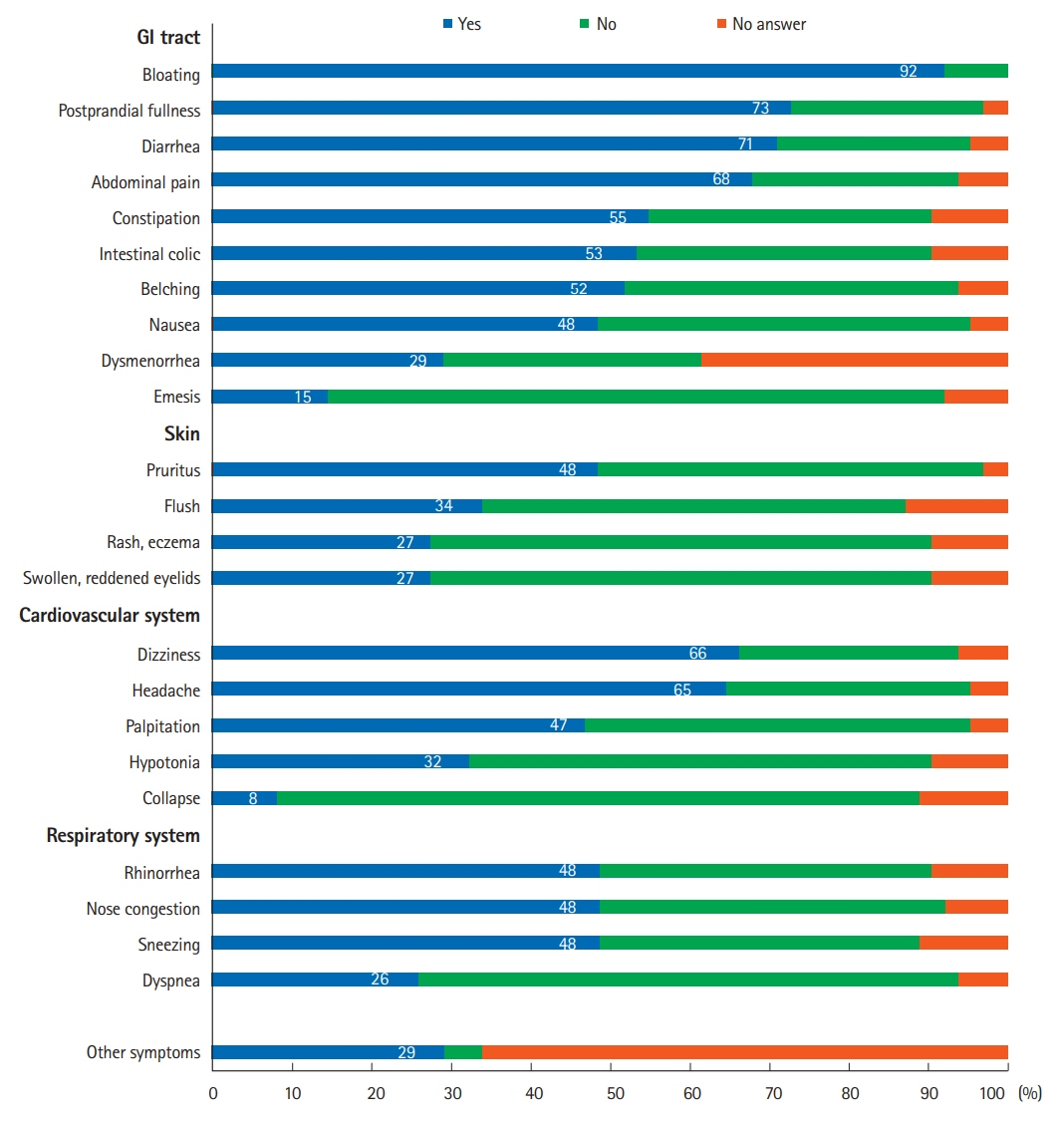Intest Res.
2019 Jul;17(3):427-433. 10.5217/ir.2018.00152.
Evaluation of symptoms and symptom combinations in histamine intolerance
- Affiliations
-
- 1Practice for General Internal Medicine, Bruck, Austria. w.schnedl@dr-schnedl.at
- 2Institute of Pathophysiology, Otto Loewi Research Centre, Medical University of Graz, Graz, Austria.
- 3Institute of Laboratory Medicine, General Hospital Steyr, Steyr, Austria.
- 4Das Kinderwunsch Institut Schenk GmbH, Dobl, Austria.
- 5Clinical Institute of Medical and Chemical Laboratory Diagnosis, Medical University of Graz, Graz, Austria.
- KMID: 2454752
- DOI: http://doi.org/10.5217/ir.2018.00152
Abstract
- BACKGROUND/AIMS
Food intolerance/malabsorption, particularly histamine intolerance (HIT), may cause nonspecific functional gastrointestinal and extraintestinal symptoms. We evaluated gastrointestinal and extraintestinal symptoms in patients with HIT.
METHODS
In an analysis of outpatients' charts we identified 133 patients, who presented with recurring nonspecific functional gastrointestinal, extraintestinal symptoms, and a diamine oxidase value <10 U/mL, indicative of HIT. A standardized anonymous questionnaire with symptoms of HIT based on known symptoms and the 4 histamine receptors including gastrointestinal, cardiovascular, respiratory and skin complaints was developed, and sent by mail to the patients.
RESULTS
In the 62 patients that completed the questionnaire, bloating was the most common and most serious symptom. Other commonly reported gastrointestinal symptoms were postprandial fullness, diarrhea, abdominal pain, and constipation. The presence of 2 from a list of 24 symptoms resulted in 276 various symptom combinations. From calculated 2.024 possible combinations of 3 symptoms the patients with HIT presented 1.975 combinations.
CONCLUSIONS
The knowledge of this wide variability of symptoms and complex symptom combinations in patients with HIT may help to clinically recognize and diagnose HIT.
MeSH Terms
Figure
Cited by 1 articles
-
Comparing histamine intolerance and non-clonal mast cell activation syndrome
Nevio Cimolai
Intest Res. 2020;18(1):134-135. doi: 10.5217/ir.2019.00087.
Reference
-
1. Reese I, Ballmer-Weber B, Beyer K, et al. German guideline for the management of adverse reactions to ingested histamine: guideline of the German Society for Allergology and Clinical Immunology (DGAKI), the German Society for Pediatric Allergology and Environmental Medicine (GPA), the German Association of Allergologists (AeDA), and the Swiss Society for Allergology and Immunology (SGAI). Allergo J Int. 2017; 26:72–79.
Article2. Maintz L, Novak N. Histamine and histamine intolerance. Am J Clin Nutr. 2007; 85:1185–1196.
Article3. Jones BL, Kearns GL. Histamine: new thoughts about a familiar mediator. Clin Pharmacol Ther. 2011; 89:189–197.
Article4. Mušič E, Korošec P, Šilar M, Adamič K, Košnik M, Rijavec M. Serum diamine oxidase activity as a diagnostic test for histamine intolerance. Wien Klin Wochenschr. 2013; 125:239–243.
Article5. Lackner S, Malcher V, Enko D, Mangge H, Holasek SJ, Schnedl WJ. Histamine-reduced diet and increase of serum diamine oxidase correlating to diet compliance in histamine intolerance. Eur J Clin Nutr. 2019; 73:102–104.
Article6. Kovacova-Hanuskova E, Buday T, Gavliakova S, Plevkova J. Histamine, histamine intoxication and intolerance. Allergol Immunopathol. 2015; 43:498–506.
Article7. Maintz L, Yu CF, Rodríguez E, et al. Association of single nucleotide polymorphisms in the diamine oxidase gene with diamine oxidase serum activities. Allergy. 2011; 66:893–902.
Article8. Sadek B, Stark H. Cherry-picked ligands at histamine receptor subtypes. Neuropharmacology. 2016; 106:56–73.
Article9. Chey WD, Kurlander J, Eswaran S. Irritable bowel syndrome: a clinical review. JAMA. 2015; 313:949–958.10. Schmulson MJ, Drossman DA. What is new in Rome IV. J Neurogastroenterol Motil. 2017; 23:151–163.
Article11. Böhn L, Störsrud S, Törnblom H, Bengtsson U, Simrén M. Self-reported food-related gastrointestinal symptoms in IBS are common and associated with more severe symptoms and reduced quality of life. Am J Gastroenterol. 2013; 108:634–641.
Article12. Newberry C, McKnight L, Sarav M, Pickett-Blakely O. Going gluten free: the history and nutritional implications of today’s most popular diet. Curr Gastroenterol Rep. 2017; 19:54.
Article13. Choung RS, Unalp-Arida A, Ruhl CE, Brantner TL, Everhart JE, Murray JA. Less hidden celiac disease but increased gluten avoidance without a diagnosis in the United States: findings from the National Health and Nutrition Examination Surveys from 2009 to 2014. Mayo Clin Proc. 2017; 92:30–38.
Article14. De Giorgio R, Volta U, Gibson PR. Sensitivity to wheat, gluten and FODMAPs in IBS: facts or fiction? Gut. 2016; 65:169–178.
Article15. Schnedl WJ, Lackner S, Enko D, Schenk M, Mangge H, Holasek SJ. Non-celiac gluten sensitivity. People without celiac disease avoiding gluten: is it due to histamine intolerance? Inflamm Res. 2018; 67:279–284.
Article16. Holtmann G, Shah A, Morrison M. Pathophysiology of functional gastrointestinal disorders: a holistic overview. Dig Dis. 2017; 35:5–13.
Article17. Talley NJ. Functional dyspepsia: new insights into pathogenesis and therapy. Korean J Intern Med. 2016; 31:444–456.
Article18. Boehm T, Pils S, Gludovacz E, et al. Quantification of human diamine oxidase. Clin Biochem. 2017; 50:444–451.
Article
- Full Text Links
- Actions
-
Cited
- CITED
-
- Close
- Share
- Similar articles
-
- Treatment of Atopic Dermatitis with a Low-histamine Diet
- A Histamine-Free Diet Is Helpful for Treatment of Adult Patients with Chronic Spontaneous Urticaria
- Effect of a Histamine-free Diet in Adult Patients with Atopic Dermatitis
- Linkage between gene marker of chromosome 11q13 and IgE-receptor mediated basophil histamine release
- Effect of Compound 48/80 on Cardiac Function and Histamine Release in Isolated Guinea Pig Hearts



